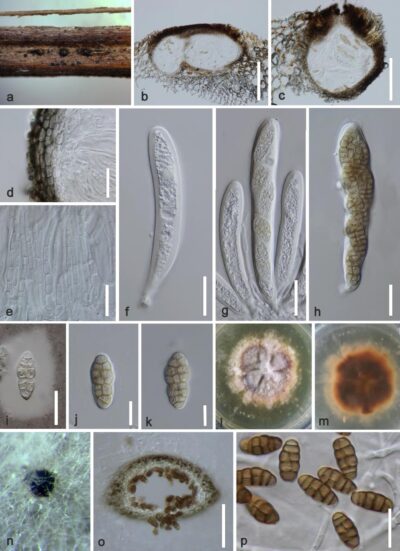Fungalpedia – Note 358, Murilentithecium
Murilentithecium Wanas., Camporesi, E.B.G. Jones & K.D. Hyde
Citation when using this data: Tibpromma et al. 2024 (in prep.) – Fungalpedia, Parasites.
Index Fungorum, Facesoffungi, MycoBank, GenBank, Fig. 1
Classification: Lentitheciaceae, Pleosporales, Pleosporomycetidae, Dothideomycetes, Pezizomycotina, Ascomycota, Fungi
Murilentithecium was established by Wanasinghe et al. (2014) using the type species Murilentithecium clematidis, based on morphology and phylogeny (LSU, SSU, TEF1, and RPB2). Later, two more species were accepted in this genus (M. lonicerae and M. rosae), and members of this genus were found in dead plant materials in China and Italy (Wanasinghe et al. 2018, Phookamsak et al. 2019). The sexual morph of Murilentithecium is characterized by coriaceous, dark brown to black ascomata, with a thick peridium and short neck; pseudoparaphyses numerous, filamentous, septate; ascospores have longitudinal and transverse septa, hyaline, muriform, yellowish-brown to brown (Wanasinghe et al. 2014). The asexual morph of Murilentithecium is described as pycnidial, solitary, dark brown, immersed, unilocular conidiomata, with a papillate ostiole; blastic, phialidic, hyaline conidiogenous cells bearing oblong, muriform conidia, constricted at the septa (Wanasinghe et al. 2018, Phookamsak et al. 2019).
Type species: Murilentithecium clematidis Wanas., Camporesi, E.B.G. Jones & K.D. Hyde
Other accepted species: Species Fungorum – search Murilentithecium
Figure 1 –Morphology of Murilentithecium. a Fruiting bodies on host substrate. b, c Ascomata. d Peridum. e Paraphyses. f–h Asci. i–k Ascospore. l, m Colonies on PDA. n Close-up of conidiomata on PDA. o Section of conidiomata. p Conidia. Scale bars: b = 150 μm, c = 200 μm, d, g, h = 30 μm, e, i–k = 10 μm, f = 20 μm, o = 100 μm, p = 15 μm. Photo resources from Wanasinghe et al. (2014).
References
Entry by
Yang EF, Department of Biology, Faculty of Science, Chiang Mai University, Chiang Mai 50200, Thailand; Center for Yunnan Plateau Biological Resources Protection and Utilization, College of Biological Resource and Food Engineering, Qujing Normal University, Qujing, Yunnan 655011, China.
(Edited by Saowaluck Tibpromma, Samaneh Chaharmiri-Dokhaharani, & Achala R. Rathnayaka)
Published online 14 November 2024
